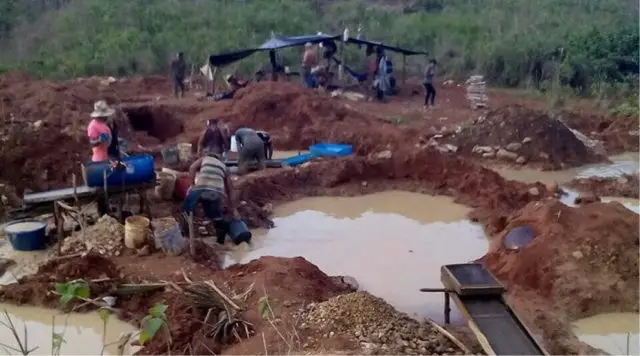As if it were the worst version of the American Old West, the Crucitas area is a problem -an old one- but one that urgently needs a prompt solution in several aspects: environmental, legal, economic, political and, above all, human.
Twelve years ago a court ruling annulled the open-pit mining concession granted to the Canadian company Infinito Gold. The company left and those lands were left to the mercy of gold prospectors.
To aggravate the situation, the deputies reformed the Mining Code – which is 40 years old – and approved the Crucitas Law, No. 8904, which prohibited open pit mining throughout the country.
Thus began a dark period for the environment in Costa Rica, because in view and patience of all previous governments, two thousand to three thousand coligalleros entered Crucitas per day, to loot the gold of all Costa Ricans.
These invaders used mercury and cyanide -two very toxic substances- to extract the precious metal, and contaminated the land, the water, caused severe environmental damage and a social drama in that community.
Plans and laws
Given the inaction and omission of the previous government, Court Chamber IV issued a ruling in which it ordered -within three months- the drafting of a Containment Plan to contain the avalanche of illegal gold miners in the area of Crucitas.
Also, the magistrates requested -in 18 months- a Remedial Plan, with the technical studies of the case, to clean the area of contaminants and repair the damage caused.
Due to the silence of the Carlos Alvarado administration, Chamber IV gave President Rodrigo Chaves three days to respond; and the president’s reaction was to go -almost immediately- to Crucitas and assess the situation “in situ”.
After the trip, in order to see the magnitude of the problem, talk with the citizens and have elements of judgment, President Chaves decided to wait for the arbitration ruling proposed by Infinito Gold, in November, and decide what will do.
On that date, it will only be resolved whether or not the compensation demanded by Infinito Gold from the state, due to the annulment of the concession, is fair or not; that ruling will not affect -at all- the underlying problem: the repair of environmental damage.
It is worth adding to the above that -since 2016- Costa Rica ratified, through Law 9391, the Minamata International Convention on Mercury, which requires the elimination of the use of that element in the country, without it having been fulfilled.
What will happen to Crucitas
The first is the effective strengthening of the Department of Geology and Mines of the Ministry of Environment and Energy (MINAE), which needs more personnel and equipment for adequate supervision.
Before the government decides to continue with the exploitation of gold, the deputies must authorize, through a law, open pit mining in the area. This reform -given that the current Mining Code dates back to 1982- must contemplate three essential elements.

Another factor would be to establish regulations concerning environmental liabilities, which in this case would be how to start cleaning up the mercury and what the entire gold mining process would look like at the end. The Environmental Technical Secretariat (SETENA) must clearly establish the terms of reference for carrying out the Environmental Impact Study.
The last would be the socialization of benefits. That is, the fair distribution of the income generated, both for the community and for the country, whether it is the payment of foreign debt, social security or other proposals.
Legislation should be based on the facts
Promoting the current model of gold exploitation left an environmental disaster due to contamination, a loss of foreign exchange due to the illegal extraction and sale of gold, in addition to the deterioration of social and living conditions in the zone.
Legislation must be based on the facts. So far, the solutions have been wrong and far from reality. Let us trust that the current administration and the deputies finally decide on the best future for Crucitas and the country.

